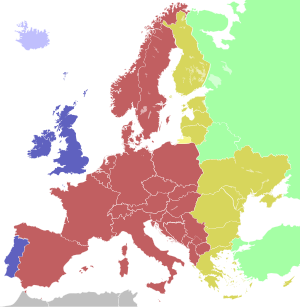Koördinearre Wrâldtiid Tiidsônes | Navigaasjemenu
Geografy
tiidskaalIngelskeFrânskeWrâldtiidGreenwich Mean TimesekondenskrikkelsekondenUT1TiidsônesJeropaNederlânwintertiidsimmertiidsinnetiidnulmeridiaan
Koördinearre Wrâldtiid
Jump to navigation
Jump to search
Koördinearre Wrâldtiid of UTC is in universele tiidskaal mei in werjefte yn 24-oers notaasje sûnder punten en sûnder oantsjuttings as "n.m." of yn it Ingelsk "am"/"pm". Oars as wat gauris tocht wurdt, is de namme "UTC" net in ôfkoarting fan de standardnamme. De standaertnammen binne it Ingelske "Coordinated Universal Time" en it Frânske "Temps universel coordonné". De namme en de ôfkoarting bine yn 1967 fêststeld.
Koördinearre Wrâldtiid is ien fan de foarmen fan Wrâldtiid, ôfkoarting UT, dy't de ferskate foarmen fan GMT (Greenwich Mean Time) ferfongen. De tiidskaal is opboud út SI-sekonden, mar wurdt troch skrikkelsekonden lykhâlden mei astronomyske tiid, UT1.
Tiidsônes |
Tiidsônes kinne beskreaun wurde mei de ôfwiking dy't hja hawwe fan UTC. Yn in grut part fan Jeropa, ek yn Nederlân, jildt foar de wintertiid UTC+1 en foar de simmertiid UTC+2 (likernôch efterelkoar 1 en 2 oere letter as de sinnetiid op de nulmeridiaan.

Tiid Jeropa

Tiidsoanes fan de wrâld
Kategory:
- Geografy
(window.RLQ=window.RLQ||[]).push(function()mw.config.set("wgPageParseReport":"limitreport":"cputime":"0.012","walltime":"0.019","ppvisitednodes":"value":11,"limit":1000000,"ppgeneratednodes":"value":0,"limit":1500000,"postexpandincludesize":"value":0,"limit":2097152,"templateargumentsize":"value":0,"limit":2097152,"expansiondepth":"value":2,"limit":40,"expensivefunctioncount":"value":0,"limit":500,"unstrip-depth":"value":0,"limit":20,"unstrip-size":"value":0,"limit":5000000,"entityaccesscount":"value":0,"limit":400,"timingprofile":["100.00% 0.000 1 -total"],"cachereport":"origin":"mw1273","timestamp":"20190330004650","ttl":2592000,"transientcontent":false););"@context":"https://schema.org","@type":"Article","name":"Kou00f6rdinearre Wru00e2ldtiid","url":"https://fy.wikipedia.org/wiki/Ko%C3%B6rdinearre_Wr%C3%A2ldtiid","sameAs":"http://www.wikidata.org/entity/Q1536","mainEntity":"http://www.wikidata.org/entity/Q1536","author":"@type":"Organization","name":"Contributors to Wikimedia projects","publisher":"@type":"Organization","name":"Wikimedia Foundation, Inc.","logo":"@type":"ImageObject","url":"https://www.wikimedia.org/static/images/wmf-hor-googpub.png","datePublished":"2005-03-24T15:12:17Z","dateModified":"2019-02-24T06:19:15Z"(window.RLQ=window.RLQ||[]).push(function()mw.config.set("wgBackendResponseTime":129,"wgHostname":"mw1272"););